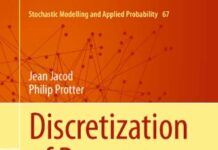
Ebook Info
- Published: 2002
- Number of pages: 264 pages
- Format: PDF
- File Size: 1.04 MB
- Authors: Jean Jacod
Description
This introduction can be used, at the beginning graduate level, for a one-semester course on probability theory or for self-direction without benefit of a formal course; the measure theory needed is developed in the text. It will also be useful for students and teachers in related areas such as finance theory, electrical engineering, and operations research. The text covers the essentials in a directed and lean way with 28 short chapters, and assumes only an undergraduate background in mathematics. Readers are taken right up to a knowledge of the basics of Martingale Theory, and the interested student will be ready to continue with the study of more advanced topics, such as Brownian Motion and Ito Calculus, or Statistical Inference.
User’s Reviews
Editorial Reviews: Review “(The book is) a lean and largely self-contained introduction to the modern theory of probability, aimed at advanced undergraduate or beginning graduate students. The 28 short chapters belie the book’s genesis as polished lecture notes; the exposition is sleek and rigorous and each chapter ends with a supporting collection of mainly routine exercises. … The authors make it clear what luggage is required for this exhilarating trek,… a good knowledge of advanced calculus, some linear algebra, and some “mathematical sophistication”. With this understood, the itinerary is immaculately paced and planned with just the right balances of technical ascents and pauses to admire the scenery. Within the constraints of a slim volume, it is hard to imagine how the authors could have done a more effective or more attractive job.” The Mathematical Gazette, Vol. 84, No 500, 2000 “The authors provide the shortest path through the twenty-eight chapter headings. The topics are treated in a mathematically and pedagogically digestible way. The writing is concise and crisp: the average chapter length is about eight pages. … Numerous exercises add to the value of the text as a teaching tool. In conclusion, this is an excellent text for the intended audience.”Short Book Reviews, Vol. 21, No. 2, 2001 About the Author
Reviews from Amazon users which were colected at the time this book was published on the website:
⭐As far as beginning graduate-level books on probability are concerned this is definitely one of the best. This looks like a set of lectures turned into a book.The competition in my mind would be
⭐(more compact, perhaps a little dense)
⭐(covers more ground and is very clear)
⭐(very detailed explanations, but you should probably have followed a course on measure theory)Please dont dive into probability at this level, your intuition might not be ready for it.To do that I recommend
⭐(if you have the time)There is also
⭐which is an excellent introduction stopping short of measure theory.
⭐Terse exposition, but while this usually helps results stand on their own and encourages the reader to fill in the details, the book’s page layout makes the material look chaotic and un-clear. Very little motivation or intuition is included as part of the anemic chapter length.Endlessly frustrating as a reference. Table of contents gives absolutely no fine information about where topics are located, and the index is as terse as the rest of the book. Good luck finding anything efficiently. Many times when I try to work with this book I’ve had to waste 10+ minutes flipping around to check basic definitions – probability density, state space, expectation, variance.Exercises are semi interesting, but the authors decided it was a good idea to include answers to some of them. In my opinion, this is idiotic in a graduate level book, as at this point students should be able to work independently or know to ask their peers/teachers for help if they are stuck. Even worse is the number of times these answers are just plain wrong. Were the authors purposely trying to deceive students in an effort to ‘help’ them learn? This is absurd and unnecessary. This degrades this book from a ‘textbook’ to a grade school style ‘workbook’Its only redeeming value is that it is cheap, but I can think of cheaper ways to decorate my desk. If you have the option, choose a different option.
⭐the statistics lecturer at my university recommended this book, and they choose to purchase it for my studies. The book holds a lot of information, and is definitely worthwhile for those who are interested in numbers. Formulas are well explained and properly documented through methodical examples.
⭐Very good. Awesome.
⭐Good
⭐This is probably my favorite math book so far. It is written in a format which I haven’t found in any other book I read: It has very short chapters and uses uniquely concise notation. The latter is especially appealing if like me one isn’t a fan of heavily analytical notation. In this book, probability theory comes first, measure theory second, and the notation reflects this: For example expectation is used instead of integrals whenever possible.The book has only minor faults, like the rare lapse in rigor, or incomprehensible step in a proof. Since this won’t be especially harmful to a reader with sufficient mathematical maturity, and because the notational style in my opinion provides such a great benefit, I rate this book 4.5 stars with a tendency towards 5.I would recommend this book for undergraduate students in their final semesters with prior exposure to non-measure-theoretic probability theory (Europe), and for beginning graduate students in the US.
⭐This book is my favorite to use as a basis for an introduction to probability theory course. It’s graduate-level material designed to give a rigorous basis for later probability based courses, and it succeeds admirably. The presentation is clear, detailed, and structured in a way that it is fairly easy to design a course around the book—one can make it a required textbook or just use it as a guide to form lecture notes. The same clear exposition and sufficient detail enables it to be used as a self-study guide, too, as long as one has a reasonably rigorous background in mathematics.It’s a bit slim and lecture/lesson-oriented to be that great as a reference book, but it’s great to build a course around, and not overly expensive for students. Highest recommendation.
⭐The opening chapters (1-6) provide a decent and readable introduction to key concepts in measure theory: sigma-algebras, (probability) measures, random variables, etc. However, the middle and later chapters are written like lecture notes –definition, theorem, proof; theorem proof; theorem, proof, corollary — with little motivation or explanation of relevance to measure theoretic probability, i.e. the lecturer would provide such motivations and explanations (unfortunately the book does not come with a lecturer). The chapters on martingales are thorough–but read like a reference rather than a text– and the token chapter on the Radon-Nikodym theorem fails to capture its importance in measure theoretic probability. Overall, this book serves as a decent introduction, but I would recommend supplementing the material with corresponding material from e.g. Ash’s Probability and Measure Theory or Billingsley’s Probability and Measure.
⭐Libro ottimo, ma attenzione perchè ha un taglio molto teorico ed è molto sintetico. L’ho usato per il corso di probabilità e mi ci sono trovato bene, è molto chiaro e non si perde in divagazioni di dubbio interesse come molti libri di testo italici. Ad alcuni miei compagni di corso non è piaciuto a causa della quasi totale assenza di esempi o parti discorsive.Le dimostrazioni sono troppo sintetiche, bisogna spesso perdere molto tempo per cercare di capire i passaggi che sono stati saltati, infatti le dimostrazioni le ho studiate solo sugli appunti.
⭐Not found.
⭐I have been studied probability on this book and the very first impression was: “Oh my God, this is impossible”. Well, reading again and again this book, the theory inside it became clearer and clearer. Nevertheless I have two essential remarks: first, theorems and definitions are too much brief; second, there is (in my opinion) a huge lack of measure theory. To conclude I suggest this book only to who has a strong background in Advanced Calculus and Real Analysis (and when I say strong I am not referring to the knowledge of integration and differentiation! I am referring to the Measure Theory and Fourier series and other advanced topics).
⭐A great read to get started on probability.
⭐Difficile studiare su questo libro, che è molto, a tratti troppo sintetico, ma può essere un utile riferimento, come tanti altri in verità, per tappare alcuni buchi della materia, sperando che non siano dimostrazioni.Mi ha spinto a scrivere un libro mio di probabilità, do la terza stella solo per questo.
⭐Not found.
⭐Libro arrivato in buone condizioni.Mi aspettavo una mail per informarmi che l’articolo era arrivato (avendone ricevuta una quando è partito). Per il resto tutto ok.
⭐Not found.
Keywords
Free Download Probability Essentials 2nd Edition in PDF format
Probability Essentials 2nd Edition PDF Free Download
Download Probability Essentials 2nd Edition 2002 PDF Free
Probability Essentials 2nd Edition 2002 PDF Free Download
Download Probability Essentials 2nd Edition PDF
Free Download Ebook Probability Essentials 2nd Edition

